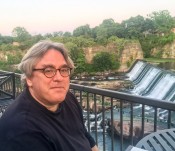Whitehot Magazine
October 2025
"The Best Art In The World"
"The Best Art In The World"
October 2025
Hiroyuki Hamada: New Work at Bookstein Projects
 Hiroyuki Hamada, #92 (detail), 2008-21. Painted plaster, 33 x 33 x 10.25 inches. Courtesy of the artist and Bookstein Projects.
Hiroyuki Hamada, #92 (detail), 2008-21. Painted plaster, 33 x 33 x 10.25 inches. Courtesy of the artist and Bookstein Projects.
Hiroyuki Hamada: New Work
March 10 through April 29, 2022
By JONATHAN GOODMAN, April 2022
Hiroyuki Hamada, born in Tokyo in 1968, moved with his family to America at the age of 18. He received his MFA from the University of Maryland. He presently lives and works in East Hampton. This show, his fifth with the gallery, presents four paintings and two sculptures. The works are abstract, evidencing in the paintings bright color and both linear and organic form. The two sculptures, very different from each other, are resolutely non-objective, being driven by the sense that the object is an independent entity, constructed by its own governance.and drive. The question of hybridity between Asian and Western form comes up, but, in Hamada’s case, this is a difficult question to answer. Perhaps it is most accurate to describe the artist as participating in the current, international language of abstraction, which may have begun in the West but now knows no boundaries.
 Hiroyuki Hamada, Untitled Painting 040, 2020. Acrylic on wood, 48 x 48 inches. Courtesy of the artist and Bookstein Projects.
Hiroyuki Hamada, Untitled Painting 040, 2020. Acrylic on wood, 48 x 48 inches. Courtesy of the artist and Bookstein Projects.
In Hamada’s work, it is difficult to assign an evident intention driving his art. No doubt the artist is in fact taken with a motive, yet it tends to remain mysterious. Perhaps the best way to experience his steadfastly evocative, but also enigmatic, art is simply to describe it. In Untitled Painting 046 (2021), Hamada has painted a tripartite structure, a bit like a vault but with a flat top, over a red ground. Two verticals, with rounded bottom edges, support a horizontal that connects the two column-like forms. On the left, at the joint connecting the horizontal and vertical elements is an area of white—a square with a corner cut off. Above the form, in the upper left, is a small black rectangle. On the right support, just under the horizontal, is a rectangle in white. One wants to assign to the painting recognizable content, but the composition does not yield to this wish; it is self-sufficiently independent of any easy reading. In the painting, Untitled 040 (040), Hamada painted a luminous but dark blue rectangle in the lower right corner; There is a large continuous line depicting a heart shape with a flat top that circles around the edge of the painting. On the upper left of the line, we see a red sphere; the bottom point of the outline is filled with a black section. At the top, a short llne extends downward from the larger lube and connects with one of two small black rectangles. It is a beautiful composition, sufficient unto itself.
 Hiroyuki Hamada, #92, 2008-21. Painted plaster, 33 x 33 x 10.25 inches. Courtesy of the artist and Bookstein Projects.
Hiroyuki Hamada, #92, 2008-21. Painted plaster, 33 x 33 x 10.25 inches. Courtesy of the artist and Bookstein Projects.
The two sculptures are equally evasive of direct meaning. #92 (2008-21) is a large circle just over ten inches deep; it ic composed of a good number of pieces of plaster, painted and pieced together to form the overall circular form. In almost all the individual components, Hamada has inserted a small metal disk with an opening, adding an understated accessory to complicate a simple surface resembling concrete. Zen-like in its enigmatic directness, the piece exists simply, without rhetoric. It refers only to its design and its materials. The other piece, #94 (2021), is made of an open scaffolding constructed from thin lengths of wood, on top of which is a form made of black resin, curved in its outline. This organic sculpture contrasts with the right angle of the wood supporting; it has a flag base that rests on the scaffolding. The title, like the other titles of the works in the show, is simply numeric, yielding no knowledge of a theme. Thus, the piece evokes form without determining a particular content. Hamada is a very good craftsman, and additionally, he is outstanding in the way he conveys presence without a recognizable subject in these very abstract paintings and sculptures. This happens in all good abstract art, but Hamada is able to invest his work with a depth that comes out of nowhere. The spirituality of the art, however implicit, is real, and is made more so by the artist’s moving reticence. WM

Jonathan Goodman
Jonathan Goodman is a writer in New York who has written for Artcritical, Artery and the Brooklyn Rail among other publications.
view all articles from this author









